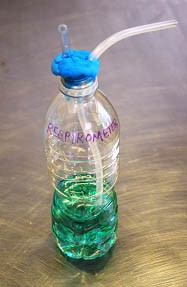Carbon Dioxide Output You Can See

[Editor's Note: Madeline Sides, 2010 Intel ISEF participant, has been testing project ideas this summer from the Science Buddies library of 1000+ science projects.]
It sometimes seems like movies and books tell us that, in life, one has to choose between being the jock or the brain, the football star or the mathematician. Hopefully, most of us grow up knowing that doesn't have to be the case and that academics and sports are not mutually exclusive. In high school, I participated in science competitions and earned varsity letters in two sports because I didn't want to be involved in just one or the other!
One of the science projects I tested recently as part of my summer internship with Science Buddies was The Effect of Exercise: Changes in Carbon Dioxide (CO2) Output (Difficulty: 6-8).In bringing together chemistry and exercise physiology, this project highlights the relationship between science and sports and exercise. As an athlete and as a developing scientist, I really enjoyed this human biology project!
As part of this project, you construct a homemade respirometer, a device that measures the amount of CO2 a human produces when breathing. This respirometer utilizes a "colorimetric pH test" to measure CO2 production. Thanks to a pH indicator solution that changes color as CO2 is blown into the solution (and lowers its pH), a test subject can actually observe his or her own CO2 production.
After a quick trip to the pet store for the pH indicator solution, some clear plastic tubing, and a small aquarium pump, I got to work assembling my respirometer using a recycled water bottle. In less than 30 minutes, my setup was complete.
I practiced blowing into the respirometer and measuring the amount of time it took the indicator solution to change from blue/green (meaning neutral, about pH 7) to light yellow (indicating a lower pH and more acidic water) because of the CO2 in my breath. After taking some "control" readings of my CO2 output before exercise, I was ready to see how the readings would change with an increase in activity. The project calls for either "moderate" activity for 10 minutes or "brisk" activity for 2-3 minutes. I decided to exercise "briskly" by running and jumping around on my driveway, which probably gave my neighbors a good laugh.
After a few sessions of jumping around, breathing into my respirometer, monitoring the color change from blue to yellow, and comparing my exercise results to my resting control, I was able to draw some conclusions about how exercise affects CO2 output in humans.
I had fun, got a bit of a workout, and got the chance to turn chemistry into an athletic event—right there in the driveway!
~ Maddy
More Maddy
Madeline Sides has been testing project ideas this summer from the Science Buddies library of 1000+ science projects. If you missed her previous post, check out her experience measuring the amount of energy in common foods.
Categories:
You Might Also Enjoy These Related Posts:
- Plastics and Earth Day - Science Projects
- Arduino Science Projects and Physical Computing
- 10+ Robotics Projects with the BlueBot Kit
- 5 STEM Activities with Marshmallow Peeps
- March Madness Basketball Science Projects: Sports Science Experiments
- Women in STEM! More than 60 Scientists and Engineers for Women's History Month
- Explore Artificial Intelligence and Machine Learning with Student AI Projects
- 10 Reasons to Do the Rubber Band Car Engineering Challenge









